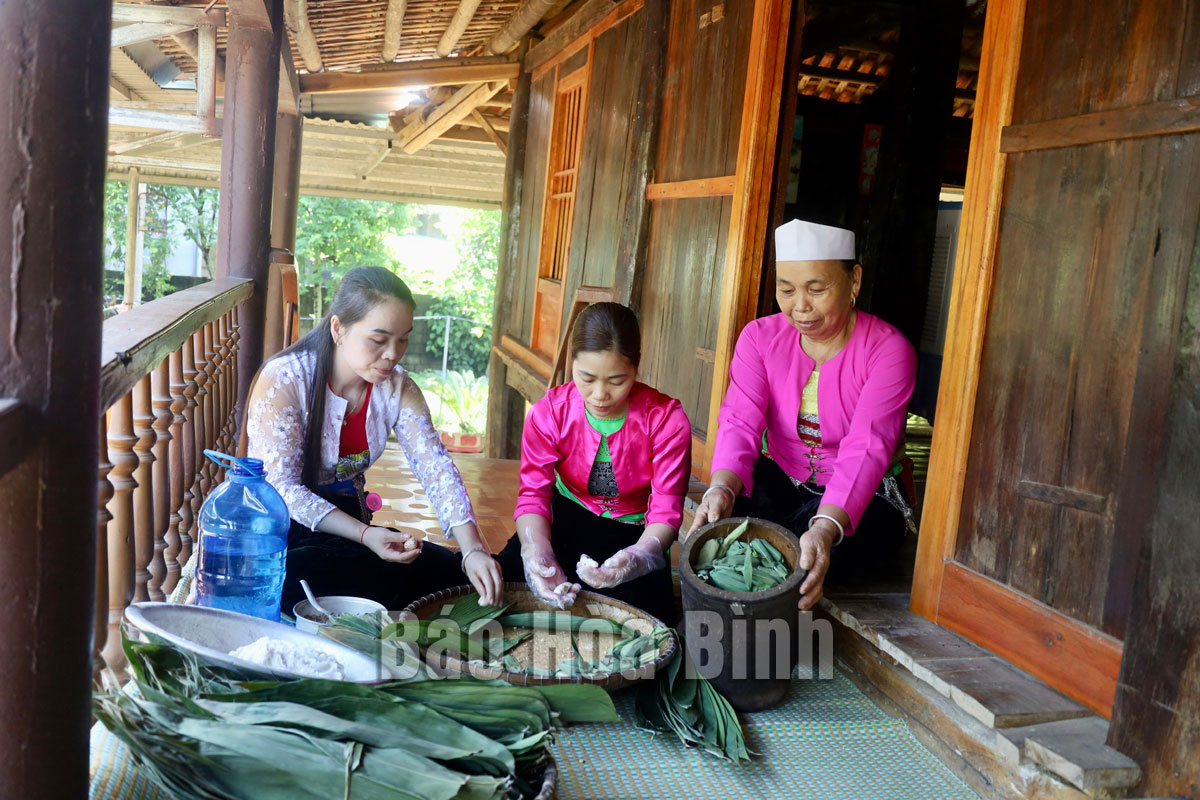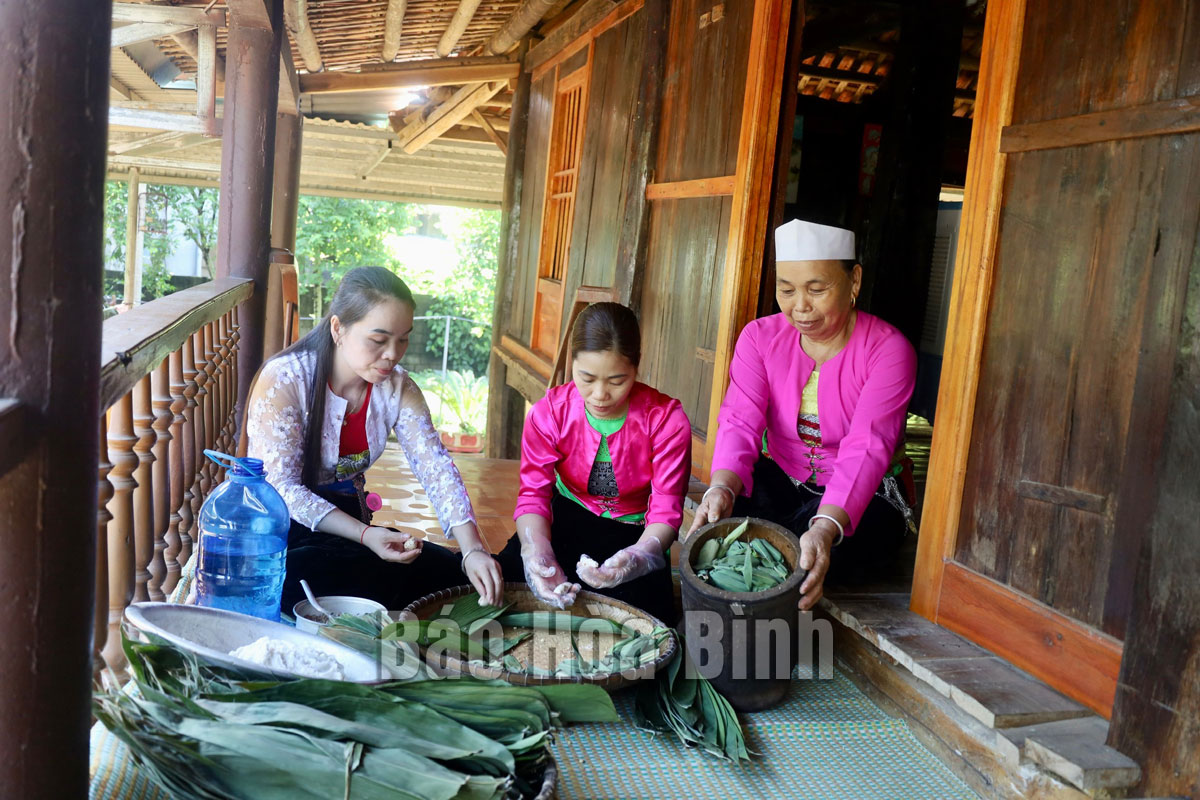
(HBO) - Muong Vang in Lac Son district is one of the four biggest and best-known Muong ethnic areas in Hoa Binh. With 91% of the local population being Muong ethnic people, the district has always paid special attention to preserving and developing the traditional cultural value.
Residents in Muong Vo region, Nhan Nghia commune (Lac Son
district), still keep the traditional cultural characteristics in their
traditional costumes and cuisine.
According to the elders in Muong Vang
, the name "Lac Son”
dates back to 1887, belonging to Lac Tho area (1466), and Lac Yen province
(1836). From 1886, Lac Son was a district of Hoa Binh province. From 1975 to
1991, it was part of Ha Son Binh province. It returned to Hoa Binh province
following the re-establishment of the province in 1991. The locality still
retains its rich traditional culture.
The acculturation and interference in the economy and culture and the Fourth
Industrial Revolution have affected the cultural values of the Muong ethnic
group in Lac Son district.
Some types of traditional cultural and artistic heritage are in danger of being
lost. Many young people do not know the Muong language or culture as well as
the habits of their ancestors.
After numerousups and downsinhistory, relics and scenic spots
in the locality have been restored and embellished to meet the cultural and
spiritual demand of the people, contributing to the locality’s socio-economic
development.
Special attention has been paid to collecting, inventorying, preserving and
displaying artifacts. The traditional house in the Muong Khoi War Zone and
relics in the district still keep many valuable artifacts in science, history,
and culture.
Diversity of tangible cultural heritage
The Stone Shelter of Vanh villageis one of the typical tangible cultural
heritage and the national archaeological relics discovered and studied in the
province. It is located at the foot of a white stone mountain in Khu Vanh
hamlet, next to the junior high school, not far from the center of the People's
Committee of Yen Phu Commune, among the four quiet mountains and forests.
The Stone Shelter of Vanh village was mentioned many times in the epic "De
dat, de nuoc” (the birth of land and water) of the Muong ethnic people in Hoa
Binh, the quintessential soul of a part of Muong Vang culture.
According to locals and history, the Stone Shelter of Vanh village is from Buoi
river, one associated with many generations of the people in Lac Son district,
locally known as the Ben Ky river section.
The Stone Shelter of Vanh village was discovered and excavated by French
archaeologist M. Colani in 1929 during an archaeological investigation in the
southern limestone area of Hoa Binh province. Locals also call the Stone
Shelter of Vanh village as a snail cave, because there are a lot of conches in
the cave.
The Stone Shelter of Vanh village is fairly large, measuring 30m in its
entrance, 18m in its depth, and 10m in its height, gradually lower inwards. The
stone roof is about 5m higher than the surrounding field. The entire part has
the traces of the cultural layers with the natural light, and the door faces
the southwest. In the picture taken by M. Colani in 1929, there is an old
banyan tree right next to the entrance of the stone roof, probably in the
period when the primitive people lived here, there were many large trees to
cover, possibly it was a thick forest in the past.
Carious types of the stone relics are found in the Stone Shelter of Vanh
village, besides the hewn tools such as triangular axes, short axes, the bladed
axes, axes with blade sharpening shoulders, full body axes, pestles, crushing
stones, stone rings, bone relics, horns, mollusk shells, and pottery relics.
The results of the excavation and the determination by C14 radiocarbon in the
Stone Shelter site of Vanh village published by M. Colani in 1930 showed that
it belongs to the Hoa Binh civilisation with a tensile date frame of 8,000 to
17,000 years ago.
The district is also home to other typical cultural - historical relic sites
such as Coi communal house in Vu Binh commune, Khoi communal house in An Nghia
commune, Khenh communcal house in Van Son commune, the historical memorial site
for the Tay Tien (March West) Regiment in Thuong Coc commune, Khu Dung cave in
Nhan Nghia commune, Bang communal house in Ngoc Lau commune, and the
"Truong Son anti-Japaneseguerrilla school” inBu Lot
hamlet,Tan My commune, among others.
Unique intangible cultural values
Coming Muong Vang in the spring, visitors will a have chance to enjoy the
bustling atmosphere of festivals, and experience the traditional cultural and
belief activities of locals.
Most festivals are held in January, such as the festivals of Khoi communal
house in An Nghia commune, Coi communal house in Vu Binh commune, Khenh
communal house in Van Son commune, and Thuong communal houses in Vu Ban town,
the Du Voi festival, the Truong Kha temple festival, and theXuong
Dong festivalin Yen Phu commune.
The organisation of traditional festivals have contributed to attracting more
tourists to the locality.
Local authorities have also paid heed to preserving other intangible cultural
heritage such as costumes, cuisine, language, ancestral worshiping rituals, Mo
Muong, folk songs and games, among others.
Notably, Muong Vang is seen as the cradle of folk songs and dances. There are
about 300 folk singers in the area.
According to Nguyen The Hung, head of the Culture and Information Office of Lac
Son district, local authorities have concentrated resources and taken many
solutions to preserve and promote the intangible cultural heritages of the
locality.
The district People's Committee has opened classes teaching gong performance,
Muong language, and making products from bamboo and rattan; set up folk song
singing clubs; preserved over 12,000 Muong stilt houses and more than 3,000
Muong gongs; and restoredand conserved10 traditional festivals./.
With an increasingly vibrant and widespread emulation movement aimed at building cultured residential areas and cultured families, Yen Thuy District has been making steady progress toward improving both the material and spiritual well-being of its people, while fostering a civilized, prosperous, beautiful, and progressive community.
Once lacking recreational spaces and community facilities, Residential Group 2 in Quynh Lam Ward (Hoa Binh City) has recently received attention for the construction of a new, spacious, and fully equipped cultural house. The project followed the model of state support combined with public contributions in both labor and funding.
The "All people unite to build cultural life" movement, which has been effectively integrated with Kim Boi district’s socio-economic development goals, is fostering a lively spirit of emulation across local residential areas, hamlets, villages, public agencies, and enterprises. In addition, through the initiative, traditional cultural values are being preserved and promoted, while community solidarity and mutual support in poverty reduction and economic development are being strengthened.
A working delegation of the Hoa Binh provincial People’s Committee led by its Permanent Vice Chairman Nguyen Van Toan on June 11 inspected the progress of a project to build the Mo Muong Cultural Heritage Conservation Space linked to tourism services in Hop Phong commune, Cao Phong district.
Born and growing in the heroic land of Muong Dong, Dinh Thi Kieu Dung, a resident in Bo town of Kim Boi district, in her childhood was nurtured by the sweet lullabies of her grandmother and mother. These melodies deeply imprinted on her soul, becoming an inseparable part of her love for her ethnic group's culture. For over 20 years, this love for her hometown has driven Dung to research, collect, and pass down the cultural values of the Muong people to future generations.
In the final days of May, the Ethnic Art Troupe of Hoa Binh Province organized performances to serve the people in remote, mountainous, and particularly disadvantaged areas within the province. These were not just ordinary artistic shows, but they were the meaningful journeys aimed at spreading cultural values, enhancing the spiritual life of the people and contributing to the preservation of ethnic minority cultural identities.



